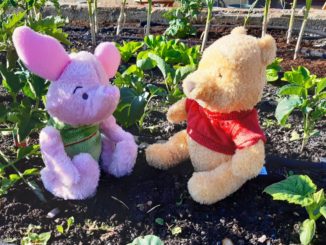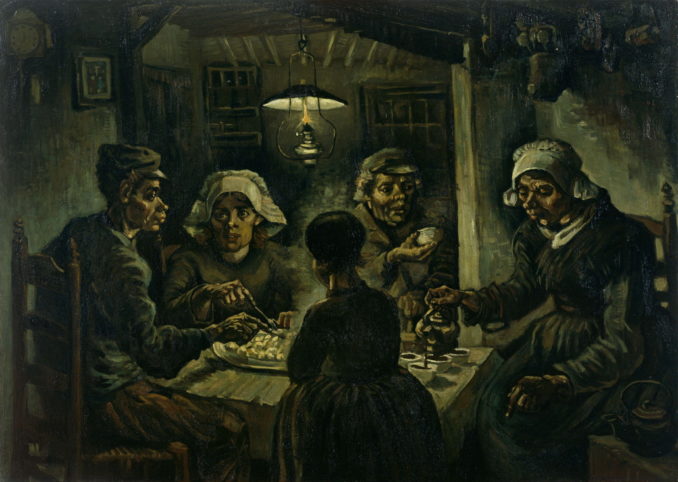
The potato is a native of the high Andes, a low-growing plant (Solanum tuberosum) with pretty purple flowers and round black fruits. To survive in its harsh environment it has evolved the habit of growing underground tubers that provide the plant with nourishment over the winter. Local people have exploited these as food. They contain the poisonous alkaloid solanine when raw, but this is broken down by cooking. That doesn’t sound like much of a start for a vegetable that is now a staple food for much of the world, but in the Andes you take what you can find and there are more than 4000 local varieties in various sizes, shapes and colours.
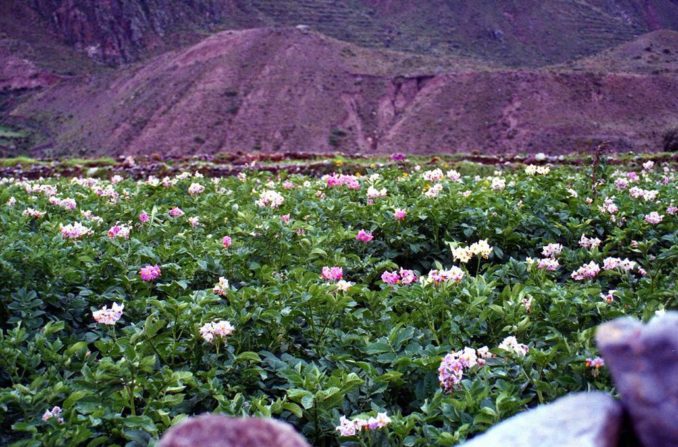
The Spanish conquistadores of the 16th century discovered the potato among much else and brought it back to Europe. It wasn’t popular, for three reasons.
First, most potato varieties will grow tubers only when they have to, to survive in the thin cold mountain air of their native habitat. Bring them down to the warmth of low altitudes and they sense favourable conditions and stop producing tubers. The natives of what is now Peru had done some work in developing lowland varieties but it remained a problem.
Second, the plant visibly belongs to the same genus as deadly nightshade (Solanum nigrum), a familiar European plant known to be poisonous enough to use as a means of murder. An Indian member of the genus, the aubergine (Solanum melongena), had an equally troubled introduction to the west, and so did another American plant, the tomato (S. lycopersicum); the fruits of both were known as ‘mad apple’, Latin mala insana, whence the Italian name melanzana for the aubergine and its generic name melongena.
Third, it arrived after the unrelated sweet potato (Ipomoea batatas) had reached Europe from tropical America in the 1590s and immediately become popular for its sweet flavour. When Shakespeare wrote ‘Let the sky rain potatoes’ in The Merry Wives of Windsor (5.5) he was referring to this. The South American potato was brought in under cover of the name of the more famous tuber and, not being sweet, was seen as inferior and uninteresting.
So the potato languished unloved in Europe. Its productiveness was recognised – you can get a lot of potatoes out of a few square yards of ground – but it was used mainly as animal fodder. In 1748 the French declared the cultivation of potatoes illegal on the completely spurious grounds that they caused leprosy. However, in Prussia the grimly practical monarch Frederick the Great recognised the potato’s value and made its cultivation compulsory for peasants, providing them with cuttings. So much for the illogical and arbitrary rule of autocrats.
Frederick’s law had an unexpected consequence. The French army pharmacist Antoine-Augustin Parmentier, fighting the Prussians in the Seven Years’ War (1756-63), was taken prisoner, and in captivity was fed on potatoes. To his surprise he discovered that they were edible and might even be palatable if properly prepared. After his release at the end of the war he made a study of nutrition, a science in its infancy, and when in 1772 the Academy of Besançon set up a contest for the best food for patients suffering dysentery, he proposed a diet based on potatoes, and won the prize. The Paris Faculty of Medicine, caught on the back foot, officially declared potatoes edible. There was still considerable resistance and intrigues lost Parmentier his post at the Invalides (the French equivalent of the British Royal Hospital for veterans), but he soldiered on and in 1779 published a recipe for a potato bread.
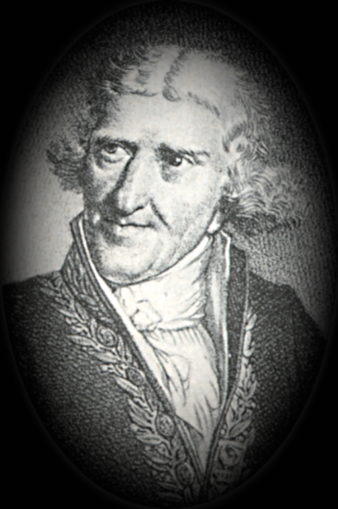
Parmentier then began an astute campaign for the potato (also including the sweet potato and the fart-inducing Jerusalem artichoke). He presented bouquets of pretty purple potato flowers to the doomed king Louis XVI and his queen Marie-Antoinette, who granted him a patch of unproductive land at Sablons near Paris for his agricultural experiments. He had the patch surrounded by armed guards during the day but withdrew them at night, deliberately allowing peasants to sneak in and steal potatoes. What better way of spreading them?
When revolution came in 1789 Parmentier was spared as a friend of the people, and a revolutionary cookbook, Mme Mérigot’s La Cuisinière républicaine, was full of potato recipes. He is honoured in French cookery by many potato dishes bearing his name, including hachis Parmentier which is what the English call shepherd’s pie.
In Bavaria, then part of the Holy Roman Empire, resistance continued. In 1785 the American scientist and adventurer Benjamin Thompson was appointed as an aide to the Bavarian ruler Prince-Elector Charles Theodore and given the tasks of reorganising the army and setting up workhouses for the poor as economically as possible. He devised a way of feeding the workhouse inmates cheaply with a soup made with barley meal, dried peas, such vegetables as were available, discarded old sour beer and – most importantly – potatoes. But such was the popular distrust of potatoes that if the hungry inmates had known that these were an ingredient, they would have refused to take the soup. He therefore had the soup prepared behind a screen so that no one could see what was going into it.

For his service to the Holy Roman Empire, Thompson was ennobled with the title of Count Rumford, one of the few Americans to have a genuine title (sorry, Duke Ellington and Earl Hines). But his potato-based soup had a serious flaw: it provided only about a third of the energy that a workhouse inmate would need to survive, and the meagre bread ration doled out with it only increased the total slightly. Thompson was one of the pioneers of the science of thermodynamics, but this was in his infancy and he had an unsound idea that serving his soup hot would increase its calorie content – which is true but only to a tiny extent which he vastly overestimated. It is not known how these unfortunate people stayed alive, but probably a combination of charitable donations of old rotting herring and simple scrounging would have kept them going.
Nevertheless, Thompson had stumbled on an important truth: of all vegetables the potato is the most complete source of nutrition, providing carbohydrates, protein and vitamins. If you have to live on just one food, potatoes will keep you alive and healthy for longer than anything else. And this was to be borne out in Ireland, one of two European countries (the other was Spain) where potatoes had been taken into the national cuisine without too much fuss. Soon Irish peasants subsisted almost entirely on potatoes, supplemented with a bit of cabbage and sparing rations of bacon from the cottager’s pig, fed on scraps and slaughtered to provide a year’s supply of meat. These small additions to an all-potato diet made it not only complete but highly nutritious, and the Irish grew tall and strong.
In the late 18th century the canal network was being set up in England. The work involved heavy digging and the puny English peasants were just not up it. Therefore the contractors imported diggers from Ireland who, nourished on potatoes, were strong enough to carry out the demanding work. The early canals were known as ‘navigations’, and the Irish workmen got the slang name of ‘navvies’. A workman would consume 8 lb of potatoes a day, boiled in a bucket over an open fire in the makeshift camps at the head of the digging.
This rough ideal could not last. In 1845 a mould now known as ‘late blight’ or scientifically as Phytophthora infestans spread through Europe, causing potatoes to rot in the ground. The Irish, uniquely dependent on potatoes, were hit harder than anyone else, and the next two years were a huge disaster of mass starvation, causing many of the inhabitants to emigrate to the United States and elsewhere and initiating a long population decline. It’s estimated that at least a million people died and two million left. British rulers’ incompetence in managing the crisis (what’s new?) led to bitter resentment that festers to this day.
One of the factors that worsened the potato famine was that almost all the potatoes grown in Ireland were of a single variety, the Irish Lumper, which happened to be particularly prone to blight. Indeed, since potatoes are propagated by sprouts on tubers (‘seed potatoes’), it is probable that most of the potatoes were genetically the same individual, distributed all over the country.
Blight returned in 1879 but was better managed. The disaster was leading scientists to realise the danger of relying on a monoculture – a single species or, worse, a single variety of a crop – which could be wiped out by a single organism. It was time to look for new varieties of potato.
No one was more enthusiastic in the search than the Russian botanist and agronomist Nikolai Vavilov, who began his work before the 1917 revolution and continued it during the early years of the Soviet Union. He set himself the task of finding the centre of origin of all the most useful agricultural crops, including potatoes, and collecting a seed bank of as many varieties as possible to use in breeding new varieties against the evil day when a disease might wipe out the established ones.

However, Vavilov encountered his own evil day. Trofim Lysenko, whom Vavilov had encouraged as a student, had found favour with Stalin for some half-baked ideas about how crops could be improved by subjecting them to a kind of Marxist discipline of planting them farther and farther north to toughen them up. Vavilov criticised this nonsense and was sacked in 1940 and sentenced to death in 1941. Although his sentence was later commuted to 20 years’ imprisonment, he died of starvation in prison in 1943. A lesson for our times about those brave souls who don’t follow the official line: we are not quite back to Stalin’s era but we are headed there.
The immensely valuable seed banks that Vavilov had built up were lost. Scientists in what was then the free world were aware of this, and the lot fell on Britain to rescue the genetic diversity of the potato. In 1938 the wonderfully named British Empire Potato Collecting Expedition set sail for South America, headed by Professor John Gregory (‘Jack’) Hawkes. Second in command was Edward K. Balls, a distinguished plant geneticist whose name is still seen in garden plant catalogues for a variety of Sisyrinchium with pretty purple flowers not unlike those of the wild potato. (I believe that he was the grandfather of our own and not particularly dear Ed Balls, though the web does not give a direct line.)
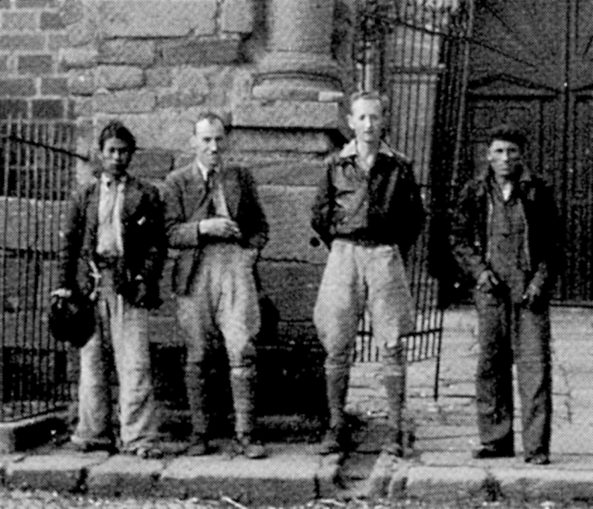
In 1939, with the Second World War already erupting, the expedition returned with many wild potatoes, and so far the seed bank has been maintained, now extended to the United States. As long as civilisation persists, come what may we shall have our chips. It’s not easy to cross-breed new varieties that resist blight, produce tubers at low altitude and are both productive and tasty, but it is possible and even a visit to an ordinary supermarket is likely to find various kinds of potato suitable for boiling or baking, chips or salads.
There is a postscript to the story of the potato. Big agriculture has still not learnt its lesson and monocultures persist, encouraged both by commercial concerns and by the bureaucrats of the EU whose quest for conformity has outlawed local varieties of several important crops. Worldwide, bananas are of huge commercial importance, but all major plantations grow the same variety, an easy choice since cultivated bananas are seedless and, like potatoes, are propagated by cuttings. In the 1950s the universally grown Gros Michel was wiped out by ‘Panama disease’ spread by the fungus Fusarium oxysporum, an organism that is almost impossible to eradicate. Luckily growers had a spare variety on hand, Cavendish, which is what you see in the shops today – it is less tasty than Gros Michel, which I remember from my childhood when a banana was a treat. But now Cavendish is threatened by a newly evolved Fusarium strain, and there is no sign that growers have an understudy that can take on the role of one of the world’s principal crops.
Copyright © Tachybaptus 2020



